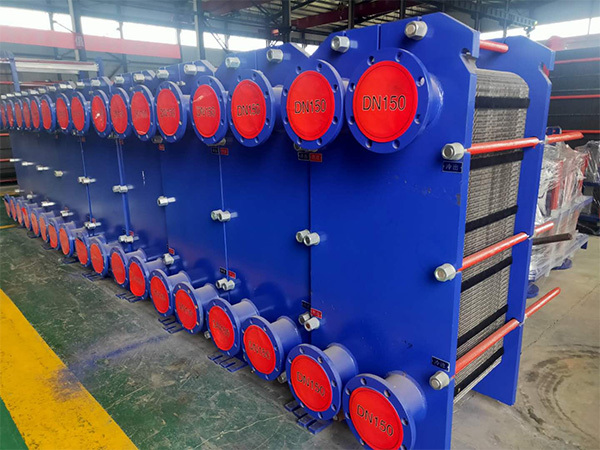How to optimize the heat transfer efficiency of plate heat exchangers
Release time:
2021-06-21 16:22
Source:
In recent years, plate heat exchanger technology has become increasingly mature. It is characterized by high heat transfer efficiency, small size, light weight, low fouling coefficient, easy disassembly and assembly, a wide variety of plates, and a wide range of applications. It has been widely used in the heating industry. Plate heat exchangers are classified into detachable, welded, brazed, and plate-shell types according to their assembly methods. Detachable plate heat exchangers are easier to disassemble and clean, allowing for flexible increase or decrease of the heat exchanger area, thus making them more commonly used in heating projects.。Detachable plate heat exchangers are limited by the heat resistance of the rubber gasket. Improving heat transfer efficiency and reducing heat exchanger resistance should be considered simultaneously. Appropriate selection and installation methods for plate materials and rubber gaskets should be used to ensure safe operation and extend the service life of the equipment.

Optimization Design Methods for Plate Heat Exchangers
01Improving Heat Transfer Efficiency
Plate heat exchangers transfer heat through the heat exchanger plates. The fluid is in direct contact with the plates, and the heat transfer methods include conduction and convection. The key to improving the heat transfer efficiency of a plate heat exchanger is to increase the heat transfer coefficient and the logarithmic mean temperature difference.To improve the heat transfer coefficient of the heat exchanger, it is necessary to simultaneously improve the surface heat transfer coefficient of the hot and cold sides of the plate, reduce the thermal resistance of the fouling layer, select plates with high thermal conductivity, and reduce the thickness of the plates. Only then can the heat transfer coefficient of the heat exchanger be improved. Plates can effectively improve heat exchange. Heat transfer coefficient of the device.
02Improving the Surface Heat Transfer Coefficient of the Plate Material
Because the corrugations of the plate heat exchanger can create turbulence in the fluid at low flow rates, a higher surface heat transfer coefficient can be obtained.。The surface heat transfer coefficient is related to the geometric structure of the plate corrugations and the flow state of the medium. The plate corrugations can be herringbone, straight, spherical, etc. After years of research and experiments, it has been found that the triangular (sinusoidal) cross-sectional shape of the corrugations has the highest surface heat transfer coefficient and uniform stress distribution, but it is difficult to process. Herringbone plates have a relatively high surface heat transfer coefficient and corrugations. The larger the angle, the higher the velocity of the medium in the inter-plate flow channel, and the larger the surface heat transfer coefficient.
03Reducing the Thermal Resistance of the Fouling Layer
The key to reducing the thermal resistance of the heat exchanger fouling layer is to prevent fouling on the plates. When the fouling thickness of the plate is1mmthe heat transfer coefficient is reduced by approximately10%. Therefore, it is necessary to monitor the water quality on both sides of the heat exchanger to prevent plate fouling and prevent foreign matter in the water from adhering to the plates. Some heating devices add chemicals to the heating medium to prevent theft and corrosion of steel parts. Therefore, attention must be paid to water quality and adhesives, which can lead to debris fouling the heat exchanger plates. If there are viscous impurities in the water, a special filter should be used for treatment. When selecting a drug, it is advisable to choose a non-sticky drug.
04Using Plate Materials with High Thermal Conductivity
Plate materials can be selected from austenitic stainless steel, titanium alloys, copper alloys, etc. Stainless steel has good thermal conductivity, high strength, good stamping performance, and is not easily oxidized. Its price is lower than titanium alloys and copper alloys. It is widely used in heating projects, but its resistance to chloride ion corrosion is poor.
05Reducing Plate Thickness
The design thickness of the plate is not related to its corrosion resistance, but to the pressure-bearing capacity of the heat exchanger. Thicker plates can improve the pressure-bearing capacity of the heat exchanger. When using a herringbone plate combination, adjacent plates are inverted, and the corrugations are in contact with each other, forming high-density, evenly distributed support points. The sealing structure at the corners and edges of the plates has been gradually improved. Under the premise of meeting the pressure-bearing capacity of the heat exchanger, the thickness of the plates should be as small as possible.
Related News

